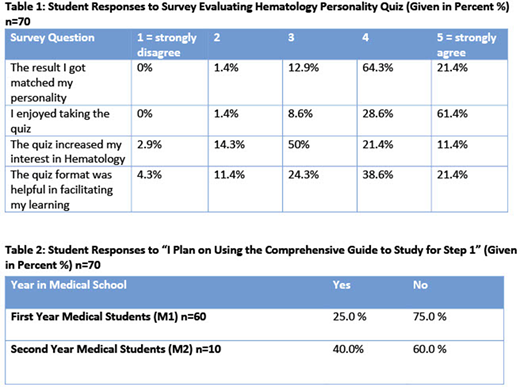Understanding hematologic cell types, their characteristics, and how they function physiologically and pathologically can be challenging to master, especially for first- or second-year medical students. The current mainstays of undergraduate medical education include lectures, PowerPoint, and supplemental textbook readings. Many learners retain information better when they feel connected to the content. Accordingly, we developed a hematology personality quiz as an innovative, fun, and memorable learning tool.
Given that our intention was to focus on foundational hematology, we included thirteen common hematologic cell types as "results" for the quiz. These included erythrocyte, reticulocyte, platelet, neutrophil, eosinophil, basophil, mast cell, monocyte, natural killer cell, CD8+ T-cell, CD4+ T-cell, mature B-lymphocyte, and plasma cell. We generated personality traits that were complementary to each cell's form and function. Platelets, for example, are very sticky cells that rely on adhesion, activation, and aggregation to achieve primary hemostasis. We translated this function into a personality type that is outgoing/communicative, touchy-feely, and always trying to connect with others, noting that platelet personalities may get "stuck" on what others think. Erythrocytes, which deliver oxygen to tissues as they squeeze into and out of vessels, were matched with energetic and flexible personality types. Working backwards from the 13 cells/personality types, we generated 20 quiz questions whose results correlated with the cells' scientific properties and personality traits. Questions included "How long would you last in a zombie apocalypse?" as well as asking quiz takers whether they rely on "gut-feelings" or are more data driven when making decisions. The former corresponded to the average life span of the cell, the latter to the innate vs adaptive immune system. The number of questions was later reduced to 13 to eliminate redundancy.
Our content was then integrated on a commercially available online quiz platform, using a frequency algorithm to generate results. Each answer corresponded to specific cell types. After answering the quiz questions, participants are paired with a single personality type that correlates with the majority of their selected responses. In addition to generating a complementary personality type, each result is coupled with information about the cell, an image of the cell under electron microscopy, as well as high yield clinical correlations. Faculty reviewed material for appropriate content. While the quiz generates one result, students have access to all thirteen results after completion.
As part of our pilot phase, the quiz and a corresponding survey were sent to all first-year medical students during the hematology learning sequence as well as second-year medical students rotating on the internal medicine clerkship. Using a Likert scale, the participants were asked to rate their enjoyment of the quiz, how well their result matched their personality, whether it facilitated learning, whether they would use the comprehensive guide to study, and if it increased their interest in hematology. Our preliminary findings (tables 1 and 2) indicate that a hematology-based personality quiz can be a fun tool to promote learning.
Ahmed:Immunovant: Other: Institutional PI on industry initiated trial; Cadence: Other: Institutional PI on industry initiated trial.
Author notes
Asterisk with author names denotes non-ASH members.


This feature is available to Subscribers Only
Sign In or Create an Account Close Modal